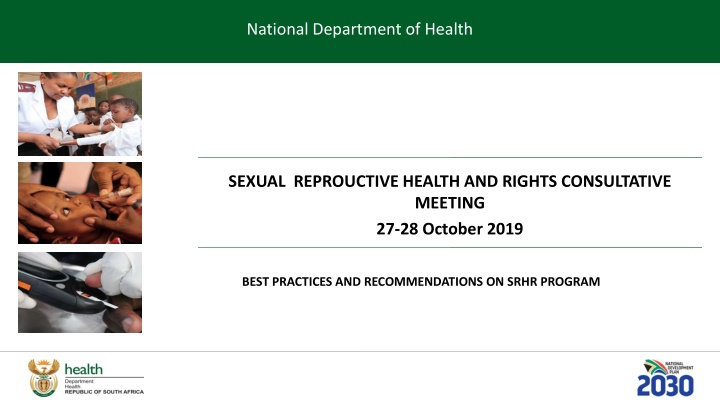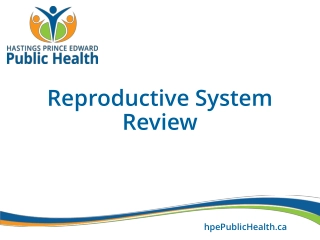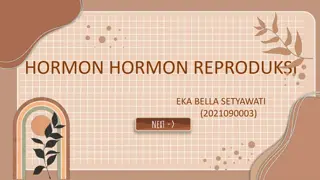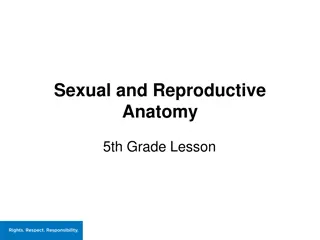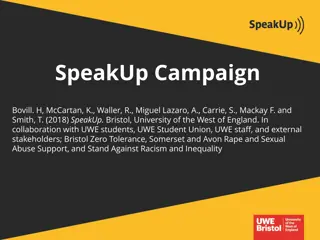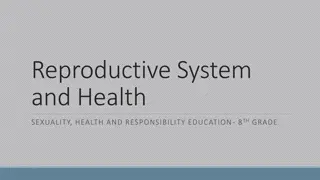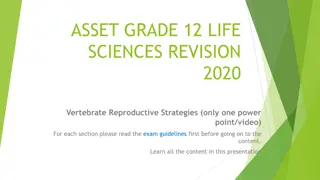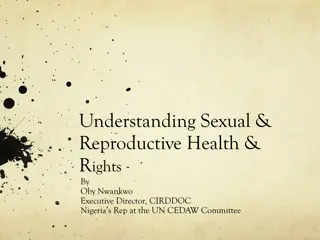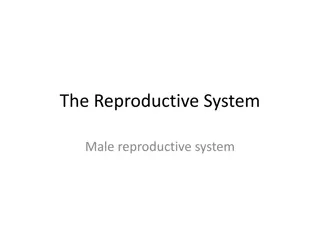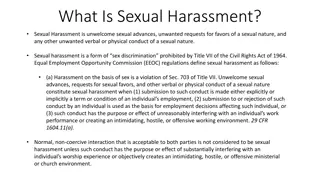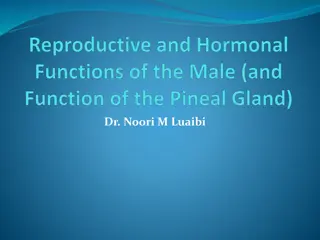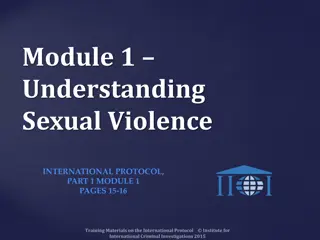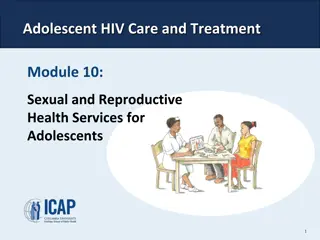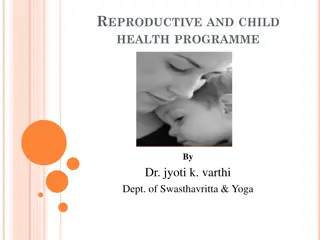Best Practices and Recommendations on Sexual and Reproductive Health Programs
Key elements of the Sexual and Reproductive Health and Rights program include modern contraceptives, prenatal and postnatal care, HIV prevention and treatment, comprehensive sexual education, safe abortion, gender-based violence, and more. The importance of ensuring a consistent supply of contraception and commodities is highlighted, along with specific projects and best practices to address stock challenges and improve accessibility. Additionally, counseling and services for a range of modern contraceptives are provided to learners in schools, emphasizing the delivery of integrated SRHR programs through education, counseling, and community-based services.
Download Presentation

Please find below an Image/Link to download the presentation.
The content on the website is provided AS IS for your information and personal use only. It may not be sold, licensed, or shared on other websites without obtaining consent from the author.If you encounter any issues during the download, it is possible that the publisher has removed the file from their server.
You are allowed to download the files provided on this website for personal or commercial use, subject to the condition that they are used lawfully. All files are the property of their respective owners.
The content on the website is provided AS IS for your information and personal use only. It may not be sold, licensed, or shared on other websites without obtaining consent from the author.
E N D
Presentation Transcript
National Department of Health SEXUAL REPROUCTIVE HEALTH AND RIGHTS CONSULTATIVE MEETING 27-28 October 2019 BEST PRACTICES AND RECOMMENDATIONS ON SRHR PROGRAM
Key elements of Sexual and Reproductive Health and Rights Programme Elements CPD PoA (see pg 47) Lancet Guttmacher 1. Modern contraceptives (Family Planning and Counselling) X X 2. Pre-natal care, safe delivery and post-natal care X X 3. Reproductive Tract Infections, Sexually transmitted infections and HIV X X 4. HIV prevention, care and support and treatment X X 5. Comprehensive Sexual Education (CSE) X X 6. Safe abortion and Post-abortion care X X 7. Gender-Based Violence (GBV) X X 8. Harmful practices including, Female Genital Mutilation (FGM); Child Marriage X X 9. Menstrual Hygiene Management (MHM) 10. Breast Cancer and cancers of the reproductive system X X 11. Prevention and treatment of sub-fertility and Infertility X X 12. Sexual Function and satisfaction X 13. Adolescent Sexual and Reproductive Health X X 2
Ensuring Consistent Supply of Contraception & TOP Commodities: Name of Project Province/Districts covered Duration Ensuring Consistent Supply of Contraception & TOP Commodities National 2017 current Best Practice: Engaging directly with suppliers, through secondment at NDoH Affordable Medicine Directorate [AMD], allowing for hands-on management of key suppliers (e.g. Bayer, Pfizer, Litha, MSD). Clear communication of NDoH priorities to suppliers (e.g. pushing SAHPRA registration of TOP combi-pack and DMPA-SC) Lessons Learnt: Regular and timely communication with suppliers can address issues before they arise (e.g. suppliers not meeting deadlines). The complexity of medicine supply chains means that issues can arise unexpectedly at any point (e.g. NET-EN stock can overheat in transit) so additional options are always required. Results Achieved: Working with AMD to take actions to mitigate stock challenges across contraceptive and TOP commodities. e.g. Assisting with Section 21 for NET-EN stock; Ensuring deliveries of IUDs and implants match increased demand; Assisting with allocation of stock based on need. Negotiated MSD s assistance in stock circulation (underway) and refund for expiring implants (awaiting approval from DBAC). Working with NEMLC and AMD to increase variety of contraceptive methods on upcoming tender HP03-2020, to be advertised Jan 2020. Way Forward: Initiate working with provinces to use NDoH surveillance system to minimise stock issues in facilities. Continue working with AMD to mitigate stock challenges whenever and wherever possible. Continue supporting the registration of commodities, their inclusion on NEMLC, and their subsequent inclusion on national tenders. 4
2. Counselling and services for a range of modern contraceptives, with a defined min. number and type of methods Name of Project Province/Districts covered Duration Ndwedwe, ILembe, KZN 6500 learners in 12 schools 2014 current Delivering an Integrated SRHR program for high school learners Best Practice: Delivering information, education, counselling, referral and linkage to a YFC clinic for SRHR services. Community-based services through Jamborees. Ongoing campaigns at schools with other partners Dedicated YFC services at health facilities Working with Educators and Schools Principals provision of SRHR training Lessons Learnt: Leveraging-off schools for the delivery of SRHR service at enables reaching underserved learners The consistent uptake of services highlights unmet needs of learners. Building trust, appropriate community entry and working with key stakeholders is critical Exploring the impact of violence Results Achieved: A over 85% uptake of the SRHR program by the learners There was a steady and consistent demand for family planning services by learners. Teenage pregnancy declined from 14% to 3% from baseline to year 1, remained below 3.5% to date. Collaboration with District Dept. of Eduction, Health, Social Dev, Municipality, Ward Committees, CBO s, NICRO, SAPS. WFP 5
KZN BEST PRACTICES Best Practice: Pap Drive 2018 and Pap Drive PLUS 2019 Objective Increasing access to contraceptive methods and integrated reproductive health services e.g. HIV, STI & male circumcision to institutions of higher learning (TVET s, Universities) to prevent unsafe TOP s and abandoned babies observed in KZN Name of Project Districts covered Duration 2018 / 2019 (excellent collaboration between National-DOH KZN DOH / UKZN Medical School) eThekwini, uMgungundlovu, Amajuba, uMkhanyakude, etc PAP DRIVE PLUS Pap Drive PLUS was a build on from the successful Pap Drive of 2018 which screened 2000+ women in one Durban setting, with follow up of other campaigns outside of Durban, reaching another 2000+ women in PMB in 2 campaigns and also other campaigns in other districts. Pap Drive Plus added other SRH services, esp contraception to post matric youth ACHIEVEMENTS: initial campaign at aMajuba TVETs had more than 3000 students presenting for contraception and other SRH services 734 uptake of HST / 319 Nuristerate / 197 IUCD / 182 subdermal implants. Subsequent SRH campaigns reached 2076 women in eThekwini, 2231 uMgungundlovu Men screened for Prostate Cancer 458 (48 PSA) Best Practice: Lessons learnt Activation campaigns are a good way of raising community awareness, improving skills of reproductive health nurses, and has a ripple effect on other districts which can easily implement similar projects thus increasing coverage in a short space of time 7
1. Comprehensive Sexuality Education and Information, counseling and services for sexual health and well- being Name of Project Province/Districts covered Duration Ndwedwe, ILembe, KZN 6500 learners in 12 schools 2014 current Delivering an Integrated SRHR program for high school learners Intervention:Information, Education, counselling and Referral for SRHR, health and welfare services Best Practice: Program design and deliver HIV prevention and SRHR Information, Education, Counselling in response to the context- working with learners, educators, caregivers and frontline staff . Lessons Learnt: There were low levels of knowledge on HIV transmisssion, persistance of stigma, myths and discrimination.This emphasises the need to provide a variety of options for education and counselling. (small groups, one-to-one and in class Exploring the impact of violence Results Achieved: Significant improvement in Knowledge, Attitudes and reported behaviour from pre and post intervention. Reduction in myths and stigma on HIV transmission Example- Reported Willingness to be HIV tested increased from 63% to 84% post intervention Collaboration with District Dept. of Eduction, Health, Social Dev, Municipality, Ward Committees, CBO s, NICRO, SAPS. WFP 9
Comprehensive Sexuality Education Name of Project Province/Districts covered Duration Partner Logo We Belong Canada Schools Project Gauteng, Eastern Cape Eastern Cape, Free State Mpumalanga August 2019 current ( e.g.) Best Practice: Planning Clear lines of communication Clear Roles and Responsibilities Accurate information and tailor made programming Monitoring and Evaluation Follow up Lessons Learnt: Prior permission letters from schools, school councils and the Department of Basic Education must be considered as part of the planning process. Risk management and unforeseen delays. Yearly school schedules for students including holidays and exams which can cause delays. Results Achieved: Convened one Dialogue in Gauteng. Data collection and created data collection tools. Compiled training manual for facilitators in provinces. Permission granted from schools due to prior engagement with previous stakeholders. Partnership with the department of basic education 10
Sexual and Reproductive Justice Name of Project Province/Districts covered Duration Partner Logo Research, policy and advocacy practice National ( and Global) 2017 current Best Practice: Life orientation, abortion counselling, DMPA concerns, Updating framing to RJ and Obstruction to Access Lessons Learnt: Need to update framing. Legacy of pop control and limited understanding of repro justice. Results Achieved: http://srjc.org.za/2019/09/10/unanswered-conundrums-questions-that-remain-after-the-echo-trial-what-should-health- providers-know/ http://srjc.org.za/2018/07/24/abortion-counselling-in-south-africa-a-step-by-step-guide-for-providers/ http://srjc.org.za/wp-content/uploads/2017/06/Life-Orientation-Policy-Brief_Final.pdf https://srjc.org.za/2019/05/06/challenges-for-achieving-sexual-and-reproductive-justice-in-south-africa/ https://ohrh.law.ox.ac.uk/lets-call-conscientious-objection-by-its-name-obstruction-of-access-to-care-and-abortion-in-south- africa/ 11
3. Information, counseling and services for sexual health and well-being Name of Project Province/Districts covered Duration Ndwedwe, ILembe, KZN 6500 learners in 12 schools 2014 current Delivering an Integrated SRHR program for high school learners Best Practice: Multi-discipliany team delivers the program. Social worker, Nurse, SAW Delivery of SRHR education to edcuators and ongoing collaboration with School Management Team. Delivery of Community outreach to reach households and community Lessons Learnt: The delivery of integrated services focusssing on health and social protection is critical. Reaching learner households is Eg assisting learners with grant access, ID, susbtance abuse, GBV, and household support is as critical. Unmet needs of HH members and broader community can be met through Jamborees Results Achieved: Consistent Uptake MMC (5% to 33%), FP services(19% at baseline to 32% post intervention) Reported willingness to have an HIV test improved from 63% to 85% Reached 14000 recipients (aged <1-94 years) in 2 years through a series of jamborees with WFP- demand creation, community strengthening Learners reported experience of the YFC improved. At baseline 53% felt respected by the service provider and 73% at post intervention Collaboration with District Dept. of Education, Health, Social Dev, Municipality, Ward Committees, CBO s, NICRO, SAPS. WFP 12
KEY RECOMMENDATIONS FROM KETHIIMPILO Deliver integrated services that address unmet health and welfare needs of adolescents and youth. Schools are key spaces that services can be leveraged-off to improve adolescents access to SRHR services. Include males and females in the interventions Deliver programs with multi-disciplinary teams- Nurses and social workers and educators , LSAs Invest in building partnerships across sectors. Review Knowledge, Attitude and reported behaviour and reinforce periodically key messages that address stigma, discrimination and education on SRHR and HIV through different methods- one-one, small groups and scripted lessons. 13
Comprehensive Sexuality Education Name of Project Province/Districts covered Duration South Africa School-Based Sexuality and HIV Prevention Activity Free State (TA), Gauteng, KZN, Mpumalanga and Western Cape 2015 2019 (extended to July 2021 Lessons Learnt: Strengthen provincial, district and school based support teams functions for referrals Service provision should be comprehensive and collaborative SGBs,parents, SMTs, ISHP and educators should fully engaged The provision of HST and condoms in school premises is not yet fully accepted by DoE Learners have shown interest in accessing PrEP, contraceptives, HST and condoms Best Practice: CSE through Scripted Lesson Plans in Life Skills and LO Grade 4-12 Curriculum. Entry points to initiate the services: Annual Teaching Plan, Health Calendar, Demand by the school and school profiling. HOW: Within school premises, 100m away from the school premises, arrange day visit to the health facility Services provided within school premises are more successful (safe space, controlled environment) The school names recording are not a requirement on the facility register. This can help to inform future planning of services needed. Results Achieved: Educators trained on CSE 5533, Learners reached through SLPs 448327, SMT=1408, HOD=1199, DoE officials=98, SGBs=1957, Parents=7810 PrEP (27) initiation, HST (78), STI screening (30), Substance Abuse (86), TB Screening (27), ANC Teen Pregnancy (48), Adherence Support (2) RH services package The services are provided in line with HIV, STI and TB policy (2017), ISHP(2012) and SOP (2019) for SRH service provision in Secondary Schools 14
Safe abortion services and treatment of complications of unsafe abortion Name of Project Province/Districts covered Duration Enhancing the Ability of Women to Obtain Comprehensive Abortion Care and Prevent Unwanted Pregnancy Gauteng and Limpopo (25 GP, 35 LP) June 2017 June 2020 (Current) Partner Logo Best Practices: Partnership with DOH at national, provincial, district, and facility levels to strengthen health system capacity, quality, and ownership Baseline assessment to provide contextual information for site selection Renovate and equip public facilities and provide training for providers to support high-quality service provision for client choice Community engagement to raise awareness and provide social support Site-level stigma reduction and sensitization through whole site orientations (Values Clarification and Attitude Transformation) Sustainability measures Training of Trainers, clinical mentoring, refreshers, more than one provider per facility Psychologist facilitated debriefing as providers feel overworked and burnt out Integration of other SRH services in abortion care e.g. cervical screening, HIV testing etc. Lessons Learnt: There is need to strengthen contraceptive counselling to ensure rights based approach and that providers are skilled in all methods Access to SRH commodities relieves systemic problems and enhances client choice Abortion stigma persists at all levels as a barrier to care Creating enabling environments for both providers and clients at facility level through engagement with facility management (WSO strategy) Community engagement for sensitization and awareness-raising Need to increase awareness on CTOP Act and its amendment for communities Need to expand 2nd tri services and create a network of second tri providers Need to increase overall # of TOP sites that are providing MVA and MA abortion care 5 days a week Opportunity to incorporate CAC training in all mainstream nursing trainings including the Diploma in Advanced Midwifery Obsolete practices being implemented in some facilities in 2nd tri services e.g D&C Adherence to policies and guidelines is a challenge Results Achieved: 20 trainers and 20 clinical mentors have been trained and are supporting facilities in GP and LP with CAC & contraceptive training and clinical mentoring 62 providers have been trained on CAC and about 50% are currently providing services in facilities in GP and LP, doctors oriented on 2nd tri MA From April 2018 to June 2019, 60 Ipas-supported facilities have provided a total of 27,311 induced abortions, with 26,742 (98%) clients receiving a form of post-abortion contraception excluding condoms, 34% (n=5,886) elected long acting and reversible contraception (LARC) methods and a steady increase has been observed in the uptake of LARC over the course of the project 16
Safe abortion services and treatment of complications of unsafe abortion Name of Project Province/Districts covered Duration Developing and Testing Interventions to Address Use of Conscientious Objection Among Public Sector Health Care Workers to Address Women s Access to safe, legal Abortion Services Gauteng, Limpopo, Eastern Cape and KwaZulu Natal October 2018 May 2020 (Current) Partner Logo Possible Best Practice: Prototyping of user-centred interventions Whole site orientation and training centered on conscientious objection Provider selection criteria prior to TOP training and allocation to TOP unit Provider support (debriefing sessions with managers, incentives and acknowledgement by management) Improvement of facility TOP signage to direct clients Lessons Learnt: Conscientious Objection is a poorly understood concept, even among those who invoke it TOP service provision is highly stigmatized and misunderstood Indecision and objection to TOP is mainly based on lack of awareness, myths and misconceptions, and religious beliefs Lack of any formal procedures for staff to register their objection to TOP services delivery Management support is crucial Way Forward: Results dissemination is ongoing Currently in second phase research, testing of interventions at facility level to note user inputs and modify interventions for improved outcomes 17
Intrauterine contraception after second trimester medical abortion Name of Project Province/Districts covered Duration Immediate versus delayed insertion of the IUD following second trimester medical abortion: A randomized controlled trial Cape Town Metro (Groote Schuur hospital and CHCs in Mitchells Plain, Hanover park, Gugulethu, South Peninsula) 2017 - 2020 Best Practice: Randomized controlled trial comparing uptake and use of the copper IUD when provided prior to discharge after medical abortion at 17-20 weeks gestation compared to referral for the IUD at a local CHC 3 weeks after abortion completion. Pre abortion counselling on method mix essential. Following immediate insertion of the IUD after second trimester MTOP, the need for follow-up string check at 6 weeks must be emphasized as expulsion not uncommon. Further analysis required before conclusions and recommendations can be formulated. Results Achieved: Immediate insertion results in increased use at 6weeks and 3 months after MTOP compared to delayed insertion. Planning underway for dissemination to stakeholders at national level in early 2020. For further detail, please email Deborah.constant@uct.ac.za Partnership with Women s Health Research Unit, UCT , Department of Obstetrics and Gynaecology, UCT and Western Cape Department of Health . 18
